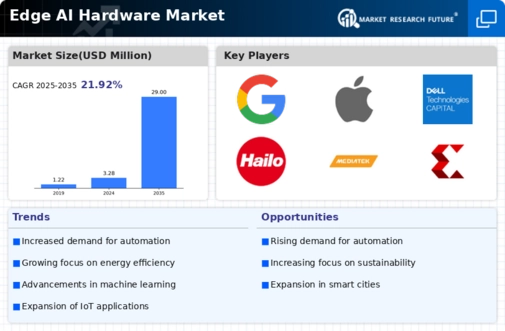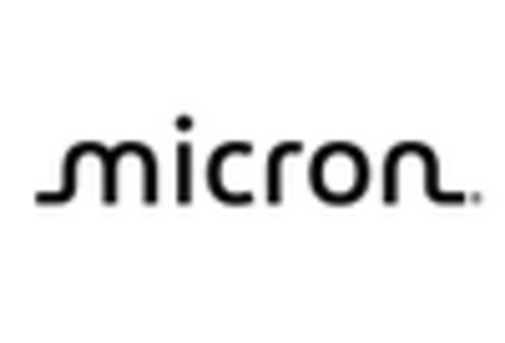-
EXECUTIVE SUMMARY 12
-
MARKET ATTRACTIVENESS ANALYSIS 15
-
MARKET INTRODUCTION 16
-
DEFINITION 16
-
SCOPE OF THE STUDY 16
-
RESEARCH OBJECTIVE 16
-
MARKET STRUCTURE 17
-
RESEARCH METHODOLOGY 18
-
MARKET DYNAMICS 25
-
OVERVIEW 25
-
DRIVERS 26
- GROWTH IN THE UTILIZATION OF ARTIFICIAL INTELLIGENCE (AI) 26
- GROWING ADOPTION OF EDGE AI DUE TO VARIOUS ADVANTAGE OFFERED BY EDGE AI 27
-
RESTRAINTS 29
- LIMITED COMPUTATIONAL POWER AND MEMORY IN EDGE DEVICES 29
- COMPLEXITY IN INTEGRATING DIVERSE EDGE AI HARDWARE COMPONENTS 29
-
OPPORTUNITIES 30
- AVAILABILITY OF CHEAP AI HARDWARE AND COST-EFFECTIVE CONNECTIVITY 30
- 5G AND 6G NETWORKS INTEGRATION 31
-
CHALLENGES: 31
-
IMPACT ANALYSIS OF COVID-19 33
- IMPACT ON SEMICONDUCTOR MANUFACTURERS 33
- IMPACT ON COMPONENT MANUFACTURERS 34
- IMPACT ON DEVICE MANUFACTURERS 34
- IMPACT ON SUPPLY CHAIN DELAY 34
-
MARKET FACTOR ANALYSIS 35
-
SUPPLY CHAIN ANALYSIS 35
- RAW MATERIAL SUPPLIERS: 35
- COMPONENT MANUFACTURING: 36
- ORIGINAL EQUIPMENT MANUFACTURERS (OEMS): 36
- SOFTWARE PROVIDERS: 36
- END USERS: 36
-
-
PORTER''S FIVE FORCES MODEL 37
- THREAT OF NEW ENTRANTS 37
- BARGAINING POWER OF SUPPLIERS 38
- THREAT OF SUBSTITUTES 38
- BARGAINING POWER OF BUYERS 38
- INTENSITY OF RIVALRY 38
-
SWOT ANALYSIS OF E- HOUSE MARKET 39
-
PESTAL ANALYSIS OF E- HOUSE MARKET 39
-
CASE STUDIES DEMONSTRATING IMPLEMAENTATION OF EDGE AI IN VARIOUS FIELDS 41
-
GLOBAL EDGE AI HARDWARE MARKET, BY COMPONENT 43
-
OVERVIEW 43
-
CPU 43
-
GPU 43
-
ASIC 43
-
FGPA 44
-
GLOBAL EDGE AI HARDWARE MARKET, BY DEVICE 45
-
OVERVIEW 45
-
SMARTPHONE 45
-
CAMERA 45
-
ROBOT 46
-
AUTOMOBILE 46
-
SMART SPEAKER 46
-
WEARABLES 46
-
SMART MIRROR 47
-
OTHERS 47
-
GLOBAL EDGE AI HARDWARE MARKET, BY POWER CONSUMPTION 48
-
OVERVIEW 48
-
0-5W 48
-
6-10W 48
-
MORE THAN 10W 48
-
GLOBAL EDGE AI HARDWARE MARKET, BY PROCESS 49
-
OVERVIEW 49
-
TRAINING 49
-
INFERENCE 49
-
-
GLOBAL EDGE AI HARDWARE MARKET, BY VERTICAL 50
-
OVERVIEW 50
-
CONSUMER ELECTRONICS 50
-
SMART HOME 50
-
AUTOMOTIVE & TRANSPORTATION 50
-
HEALTHCARE 51
-
AEROSPACE & DEFENSE 51
-
GOVERNMENT 51
-
CONSTRUCTION 52
-
OTHERS 52
-
GLOBAL EDGE AI HARDWARE MARKET, BY REGION 53
-
OVERVIEW 53
-
NORTH AMERICA 53
-
EUROPE 53
-
ASIA-PACIFIC 54
-
REST OF THE WORLD 54
-
COMPETITVE LANDSCAPE 55
-
COMPETITIVE BENCHMARKING 56
-
VENDOR SHARE ANALYSIS 57
-
RECENT DEVELOPMENTS 58
- PRODUCT DEVELOPMENT 58
-
COMPANY PROFILE 61
-
INTEL CORPORATION 61
- COMPANY OVERVIEW 61
- FINANCIAL OVERVIEW 62
- PRODUCTS/SOLUTIONS/SERVICES OFFERED 62
- KEY DEVELOPMENTS 63
- SWOT ANALYSIS 64
- KEY STRATEGIES 64
-
ARM LIMITED 65
- COMPANY OVERVIEW 65
- FINANCIAL OVERVIEW 66
- PRODUCTS/SOLUTIONS/SERVICES OFFERED 66
- KEY DEVELOPMENTS 67
- SWOT ANALYSIS 68
- KEY STRATEGIES 68
-
-
HUAWEI TECHNOLOGIES CO. LTD. 69
- COMPANY OVERVIEW 69
- FINANCIAL OVERVIEW 70
- PRODUCTS/SOLUTIONS/SERVICES OFFERED 70
- KEY DEVELOPMENTS 70
- SWOT ANALYSIS 71
- KEY STRATEGIES 71
-
MICROSOFT 72
- COMPANY OVERVIEW 72
- FINANCIAL OVERVIEW 73
- PRODUCTS/SOLUTIONS/SERVICES OFFERED 73
- KEY DEVELOPMENTS 74
- SWOT ANALYSIS 74
- KEY STRATEGIES 75
-
SAMSUNG ELECTRONICS CO., LTD. 76
- COMPANY OVERVIEW 76
- FINANCIAL OVERVIEW 77
- PRODUCTS OFFERED 77
- KEY DEVELOPMENTS 78
- SWOT ANALYSIS 78
- KEY STRATEGIES 78
-
GOOGLE INC. (ALPHABET INC.) 79
- COMPANY OVERVIEW 79
- FINANCIAL OVERVIEW 80
- PRODUCTS OFFERED 80
- KEY DEVELOPMENTS 81
- SWOT ANALYSIS 81
- KEY STRATEGIES 81
-
NVIDIA CORPORATION 82
- COMPANY OVERVIEW 82
- FINANCIAL OVERVIEW 83
- PRODUCTS OFFERED 83
- KEY DEVELOPMENTS 84
- SWOT ANALYSIS 84
- KEY STRATEGIES 84
-
-
QUALCOMM 85
- COMPANY OVERVIEW 85
- FINANCIAL OVERVIEW 86
- PRODUCTS OFFERED 86
- KEY DEVELOPMENTS 87
- SWOT ANALYSIS 87
- KEY STRATEGIES 87
-
MEDIATEK INC. 88
- COMPANY OVERVIEW 88
- FINANCIAL OVERVIEW 89
- PRODUCTS OFFERED 89
- KEY DEVELOPMENTS 90
- SWOT ANALYSIS 90
- KEY STRATEGIES 90
-
XILINX INC. 91
- COMPANY OVERVIEW 91
- FINANCIAL OVERVIEW 92
- PRODUCTS OFFERED 93
- KEY DEVELOPMENTS 93
- SWOT ANALYSIS 94
- KEY STRATEGIES 94
-
APPLE INC. 95
- COMPANY OVERVIEW 95
- FINANCIAL OVERVIEW 96
- PRODUCTS OFFERED 97
- KEY DEVELOPMENTS 97
- SWOT ANALYSIS 98
- KEY STRATEGIES 98
-
DELL TECHNOLOGIES INC. 99
- COMPANY OVERVIEW 99
- FINANCIAL OVERVIEW 100
- PRODUCTS OFFERED 100
- KEY DEVELOPMENTS 101
- SWOT ANALYSIS 101
- KEY STRATEGIES 101
-
-
MICRON TECHNOLOGY 102
- COMPANY OVERVIEW 102
- FINANCIAL OVERVIEW 103
- PRODUCTS OFFERED 103
- KEY DEVELOPMENTS 104
- SWOT ANALYSIS 104
- KEY STRATEGIES 104
-
IMAGINATION TECHNOLOGIES LIMITED 105
- COMPANY OVERVIEW 105
- PRODUCTS OFFERED 105
- KEY DEVELOPMENTS 105
- SWOT ANALYSIS 106
- KEY STRATEGIES 106
-
HAILO 107
- COMPANY OVERVIEW 107
- PRODUCTS OFFERED 107
- KEY DEVELOPMENTS 107
- SWOT ANALYSIS 108
- KEY STRATEGIES 108
-
-
LIST OF TABLES
-
PRODUCT DEVELOPMENT 58
-
PARTNERSHIP 59
-
INTEL CORPORATION: PRODUCTS/SOLUTIONS/SERVICES OFFERED 62
-
INTEL CORPORATION: KEY DEVELOPMENTS 63
-
ARM LIMITED: PRODUCTS/SOLUTIONS/SERVICES OFFERED 66
-
ARM LIMITED: KEY DEVELOPMENTS 67
-
HUAWEI TECHNOLOGIES CO. LTD.: PRODUCT/SOLUTION/SERVICE OFFERED 70
-
MICROSOFT: PRODUCTS/SOLUTIONS/SERVICES OFFERED 73
-
MICROSOFT: KEY DEVELOPMENTS 74
-
SAMSUNG ELECTRONICS CO., LTD.: PRODUCTS OFFERED 77
-
SAMSUNG ELECTRONICS CO., LTD.: KEY DEVELOPMENTS 78
-
GOOGLE INC (ALPHABET INC.): PRODUCTS OFFERED 80
-
GOOGLE INC (ALPHABET INC.): KEY DEVELOPMENTS 81
-
NVIDIA CORPORATION: PRODUCTS OFFERED 83
-
NVIDIA CORPORATION: KEY DEVELOPMENTS 84
-
QUALCOMM: PRODUCTS OFFERED 86
-
QUALCOMM: KEY DEVELOPMENTS 87
-
MEDIATEK INC.: PRODUCTS OFFERED 89
-
MEDIATEK INC.: KEY DEVELOPMENTS 90
-
XILINX INC.: PRODUCTS OFFERED 93
-
XILINX INC.: KEY DEVELOPMENTS 93
-
APPLE INC.: PRODUCTS OFFERED 97
-
APPLE INC.: KEY DEVELOPMENTS 97
-
DELL TECHNOLOGIES INC.: PRODUCTS OFFERED 100
-
MICRON TECHNOLOGY: PRODUCTS OFFERED 103
-
MICRON TECHNOLOGY: KEY DEVELOPMENTS 104
-
IMAGINATION TECHNOLOGIES LIMITED: PRODUCTS OFFERED 105
-
IMAGINATION TECHNOLOGIES LIMITED: KEY DEVELOPMENTS 105
-
HAILO: PRODUCTS OFFERED 107
-
HAILO: KEY DEVELOPMENTS 107
-
-
LIST OF FIGURES
-
MARKET SYNOPSIS 14
-
MARKET ATTRACTIVENESS ANALYSIS: GLOBAL EDGE AI HARDWARE MARKET 15
-
GLOBAL EDGE AI HARDWARE MARKET: STRUCTURE 17
-
BOTTOM-UP AND TOP-DOWN APPROACHES 22
-
MARKET DYNAMICS: GLOBAL EDGE AI HARDWARE MARKET 25
-
ADVANATAGES OF EDGE AI 27
-
DRIVERS: IMPACT ANALYSIS 28
-
RESTRAINT: IMPACT ANALYSIS 30
-
GLOBAL E- HOUSE MARKET: VALUE CHAIN 35
-
PORTER''S FIVE FORCES ANALYSIS OF GLOBAL EDGE AI HARDWARE MARKET 37
-
GLOBAL EDGE AI HARDWARE MARKET – SWOT ANALYSIS 39
-
GLOBAL EDGE AI HARDWARE MARKET: COMPETITIVE BENCHMARKING 56
-
VENDOR SHARE ANALYSIS (2022, %) 57
-
INTEL CORPORATION: FINANCIAL OVERVIEW SNAPSHOT 62
-
INTEL CORPORATION: SWOT ANALYSIS 64
-
ARM LIMITED (PART OF SOFTBANK GROUP): FINANCIAL OVERVIEW SNAPSHOT 66
-
ARM LIMITED: SWOT ANALYSIS 68
-
HUAWEI TECHNOLOGIES CO. LTD.: FINANCIAL OVERVIEW SNAPSHOT 70
-
HUAWEI TECHNOLOGIES CO. LTD.: SWOT ANALYSIS 71
-
MICROSOFT: FINANCIAL OVERVIEW SNAPSHOT 73
-
MICROSOFT: SWOT ANALYSIS 74
-
SAMSUNG ELECTRONICS CO., LTD.: FINANCIAL OVERVIEW SNAPSHOT 77
-
SAMSUNG ELECTRONICS CO., LTD.: SWOT ANALYSIS 78
-
GOOGLE INC (ALPHABET INC.): FINANCIAL OVERVIEW SNAPSHOT 80
-
GOOGLE INC (ALPHABET INC.): SWOT ANALYSIS 81
-
NVIDIA CORPORATION: FINANCIAL OVERVIEW SNAPSHOT 83
-
NVIDIA CORPORATION: SWOT ANALYSIS 84
-
QUALCOMM: FINANCIAL OVERVIEW SNAPSHOT 86
-
QUALCOMM: SWOT ANALYSIS 87
-
MEDIATEK INC.: FINANCIAL OVERVIEW SNAPSHOT 89
-
MEDIATEK INC.: SWOT ANALYSIS 90
-
XILINX INC.: FINANCIAL OVERVIEW SNAPSHOT 92
-
XILINX INC.: SWOT ANALYSIS 94
-
APPLE INC.: FINANCIAL OVERVIEW SNAPSHOT 96
-
APPLE INC.: SWOT ANALYSIS 98
-
DELL TECHNOLOGIES INC.: FINANCIAL OVERVIEW SNAPSHOT 100
-
DELL TECHNOLOGIES INC.: SWOT ANALYSIS 101
-
MICRON TECHNOLOGY: FINANCIAL OVERVIEW SNAPSHOT 103
-
MICRON TECHNOLOGY: SWOT ANALYSIS 104
-
IMAGINATION TECHNOLOGIES LIMITED: SWOT ANALYSIS 106
-
HAILO: SWOT ANALYSIS 108'


















Leave a Comment